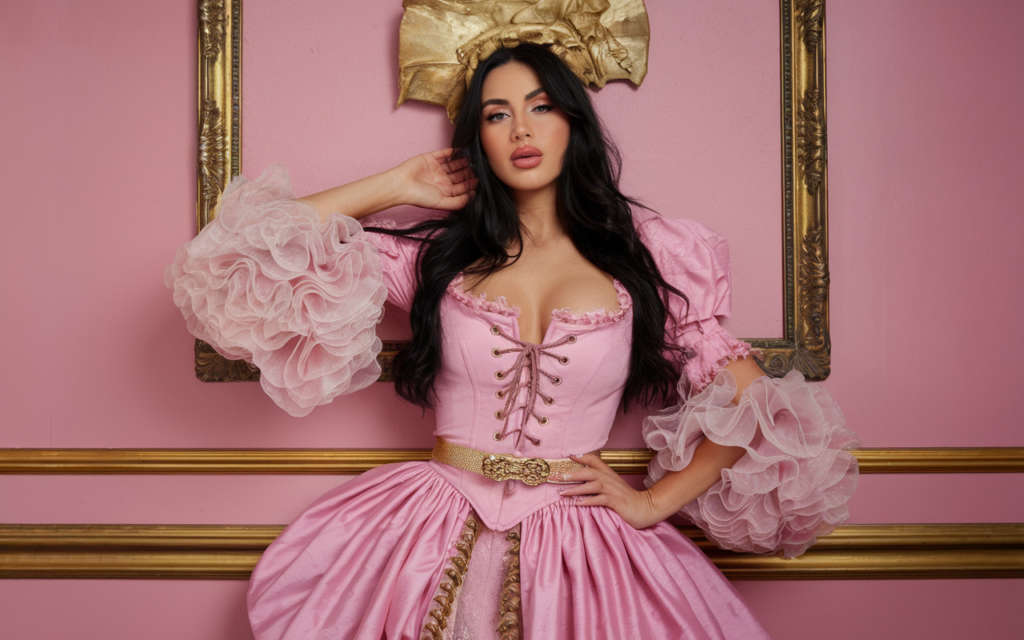
In a world that often equates self-care with bubble baths and meditation, it’s easy to overlook the transformative power of self-adornment. What we wear isn’t just about covering our bodies; it’s a form of self-expression, a declaration of worth, and—when done with intention—a celebration of self-love.
For years, I dressed to blend in, choosing “safe” outfits that wouldn’t draw attention. I thought confidence came from the inside only, and while that’s partially true, I didn’t realize how much my external choices reflected my internal world. When I started dressing with intention—choosing pieces that made me feel radiant instead of just presentable—I felt an unexpected shift in my self-worth. It was as if I was finally allowing myself to be seen.
Few historical periods embody the art of self-adornment better than the Rococo era. With its lavish fabrics, intricate embroidery, and unapologetically bold colors, Rococo fashion wasn’t about blending in—it was about standing out, embracing beauty, and indulging in the joy of being seen. But beyond the aesthetic, it reflected a mindset that can teach us how to cultivate self-love in our modern lives.
Let’s explore how this opulent style serves as a reminder that self-adornment isn’t vanity—it’s art, and it’s love.
Rococo Fashion: A Celebration of Individuality
The Opulence of Rococo
Emerging in 18th-century France, Rococo fashion was characterized by pastel colors, floral patterns, ribbons, lace, and extravagantly layered gowns. Accessories like elaborate wigs, fans, and jewels completed the look.
What It Symbolized: Rococo style wasn’t about necessity; it was about celebration. It embodied a life philosophy centered on joy, beauty, and self-expression. Dressing up was an act of creating art with your appearance.
Individual Flourishes
While Rococo fashion followed trends, it also left room for personal touches. From embroidered initials to custom jewelry, people infused their style with unique elements that reflected their personality and tastes.
What It Teaches Us Today: Even in a world of fast fashion, there’s power in making your style your own. Adding personal touches—like a signature piece of jewelry or a favorite color—can make dressing up feel like an act of self-celebration.
What Rococo Fashion Can Teach Us About Self-Love
Beauty as an Act of Intention
Rococo fashion wasn’t about throwing on the first thing you saw in your wardrobe. Every outfit was chosen with care, designed to reflect the wearer’s personality and mood. This intentionality transformed dressing into an act of self-care.
Modern Takeaway: Self-love thrives in intentionality. Taking the time to choose clothes that make you feel confident and beautiful is a way of honoring yourself.
Action Step: Spend a few extra minutes in the morning selecting an outfit that feels like you. Even small details—like adding a scarf or wearing a favorite color—can shift your energy.
The Joy of Indulgence
The Rococo era celebrated indulgence, not as excess, but as a way to honor life’s pleasures. Dressing up wasn’t just for special occasions—it was a daily ritual of joy.
Modern Takeaway: Indulging in beauty, whether through fashion, makeup, or accessories, isn’t frivolous—it’s an act of self-appreciation.
Action Step: Treat yourself to a small “luxury,” whether it’s wearing a piece of jewelry you save for special occasions or spritzing on your favorite perfume just because.
Confidence in Being Seen
Rococo fashion was designed to attract attention. Bold colors, intricate designs, and elaborate hairstyles encouraged wearers to embrace visibility and celebrate their uniqueness.
Modern Takeaway: Self-love includes allowing yourself to be seen and celebrated. Dressing in ways that reflect your true self helps you show up authentically in the world.
Action Step: The next time you dress up, ask yourself: Am I choosing this because it’s “safe,” or because it feels like me? Experiment with a bold piece that makes you feel radiant.
The Ritual of Dressing Up as Self-Love
Transforming the Mundane Into the Sacred
For many, getting dressed is a mundane task. Rococo fashion reminds us that even everyday rituals can become acts of love and creativity.
Action Step: Turn your morning routine into a ritual. Play music, light a candle, or take a moment to set an intention for how you want to feel as you choose your outfit.
Embracing Playfulness
Rococo style was playful—think whimsical patterns, oversized bows, and pastel wigs. It wasn’t afraid to have fun, reminding us that self-expression doesn’t have to be serious.
Modern Takeaway: Allow yourself to experiment with fashion. Try that bold lipstick or mix patterns you’d usually avoid. Playfulness in self-adornment is a reminder that self-love doesn’t have to be so rigid.
Dressing for Your Inner Child
Many Rococo designs, with their florals, lace, and lighthearted aesthetic, evoke a sense of childlike wonder. Dressing up in this way can help you reconnect with your inner child—the part of you that loved twirling in dresses or pretending to be royalty.
Action Step: The next time you shop or get dressed, ask yourself: What would my inner child love to wear? Adding a playful accessory or whimsical detail can reconnect you with that part of yourself.
Real-Life Examples of Modern Rococo Self-Adornment
The Statement Accessorizer
A woman who loves Rococo-inspired jewelry wears ornate brooches or pearl earrings to meetings, transforming her workday outfits into expressions of her personality.
The Playful Dresser
A man incorporates Rococo-style prints—like florals and pastels—into his wardrobe, finding that the lighthearted designs boost his mood and creativity.
The Ritual Enthusiast
A busy mom uses her morning routine as a time to adorn herself with scarves and vintage-inspired pieces, reminding herself that she’s worthy of beauty, even on chaotic days.
Self-Love Is an Art
Rococo fashion teaches us that self-adornment isn’t vanity—it’s an art form, a ritual, and a declaration of worth. Whether through bold colors, playful patterns, or a touch of luxury, the way you dress can become a powerful tool for self-love.
So, take a cue from the Rococo era: Dress with intention. Celebrate your beauty. Indulge in the joy of being seen. Because when you adorn yourself with love, you’re not just wearing clothes—you’re wearing your worth.
